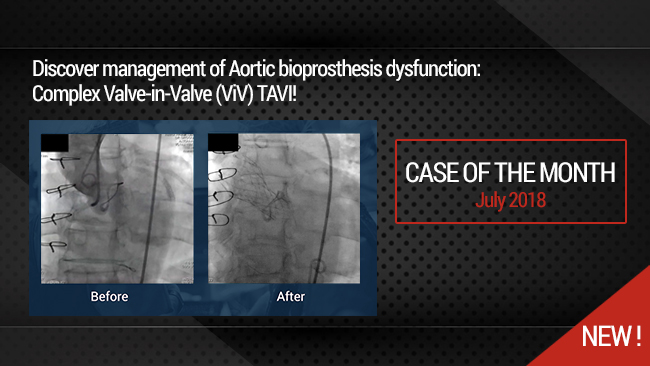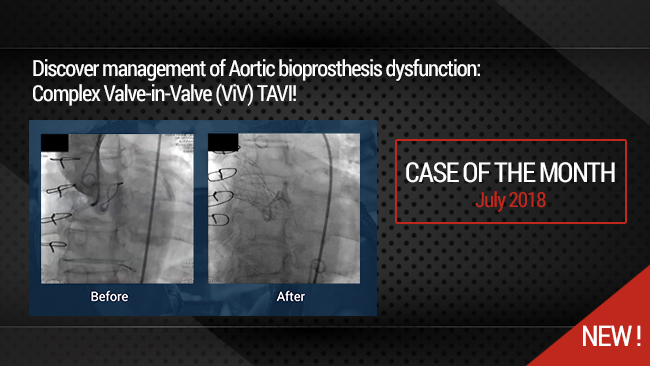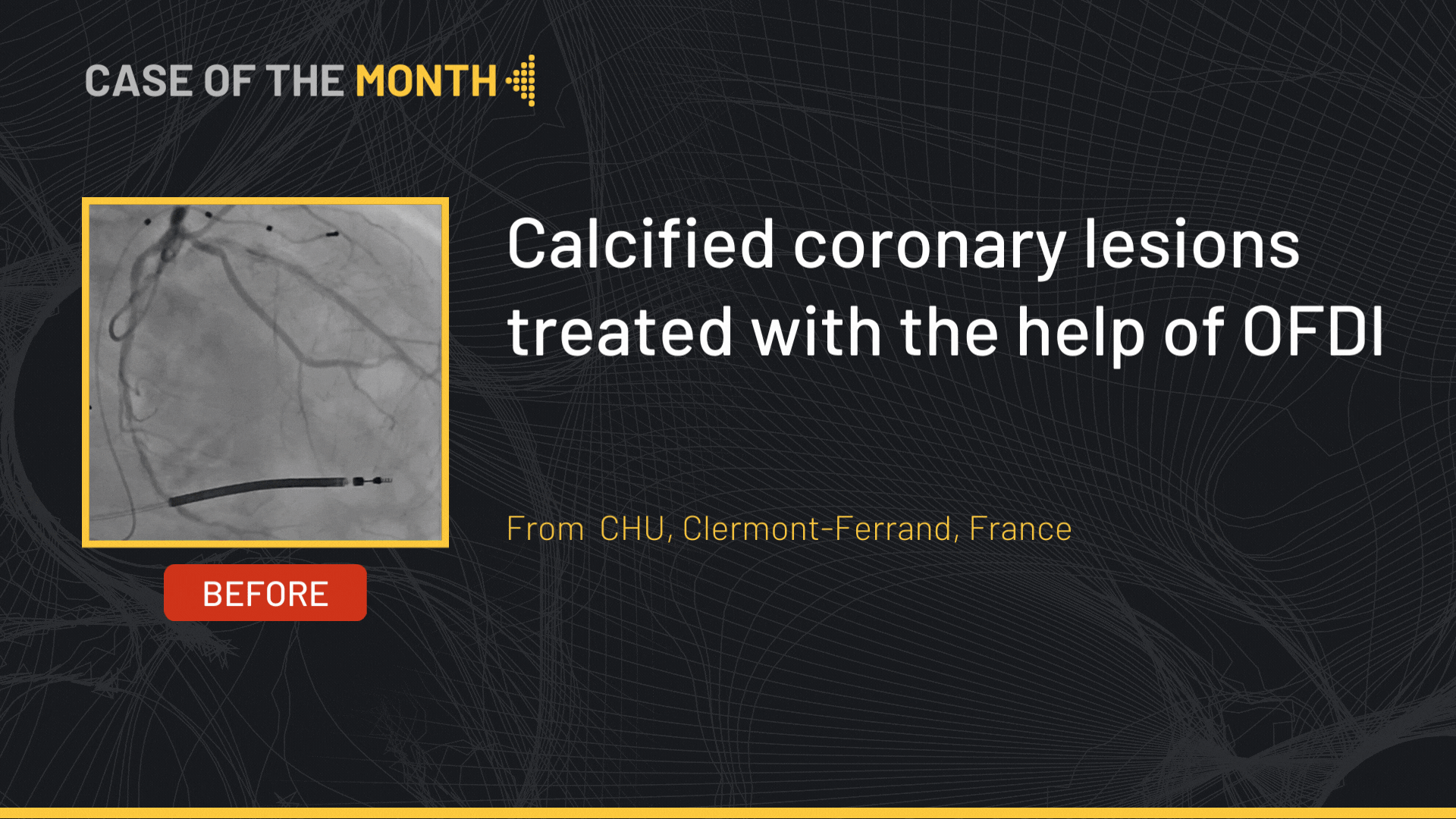×
It looks like you're using an obsolete version of internet explorer. Internet explorer is no longer supported by Microsoft since the end of 2015. We invite you to use a newer browser such as Firefox, Google Chrome or Microsoft Edge.
Complex Valve-in-Valve (VIV) TAVI for Aortic bioprosthesis dysfunction
Case of the Month: July 2018
This didactic procedure concerns a 81 y.o gentelman, with history of Surgical Aortic valve bioprosthesis replacement with Mitroflow 21; presenting heart failure due to severe aortic prosthesis dysfunction (severe Aortic regurgitation); after Heart Team discussion, he was considered for Valve-in-Valve TAVI With Auto-expandable Evolut-R valve.
Educational objectives
- Optimal Echo-guided Femoral access for TAVI Procedures.
- Managing degenerative aortic bioprosthesis with Valve -in-Valve implantation in High risk patients.
- Optimal choice and sizing of the Valve-in-Valve device.
- Dealing with Valve positioning and deployment in case of severe Aortic regurgitation.
- Protection of coronary arteries from occlusion in High risk patients during TAVI procedures.
Step-by-Step Procedure
- Echo-guided Right Femoral artery access, Left femoral access & right radial artery access.
- Right Femoral artery access 14F, Left femoral artery access 7F, Right radial artery access 5F.
- Protection of the Right coronary artery with 7F JR4 guiding catheter & workhorse coronary guidewire (Sion blue) (Over left femoral access).
- Placing a 5Fr Pigtail catheter in the ascending aorta through Right Radial access.
- Preclosing the right Femoral access with two Proglide devices (Abbott).
- First evaluation aortography.
- Crossing the degenerated valve with AL1 5F Catheter and regular wire.
- Loading the 14 F introducer.
- Pre-implantation Pressure parameters recording.
- Exchange the regular guidewire with Safari guidewire.
- Evolut-R Valve loading, Fluoroscopic chek of the valve.
- Evolut-R valve optimal positioning, recapture and second positioning for best compromise between coronary occlusion risk and transvalvular residual gradient.
- Partial release of the Evolut-R valve and angiographic control.
- Pulling back the Pigtail 5F Catheter & the JR4 7F protection guiding catheter.
- Final release of the valve.
- Post-implantation pressure parmeters recording.
- Angiographic control of the Coronary arteries patency.
- Final angiographic result.
- Femoral access closure with Proglide devices.
Biobliography
-
2017 ESC/EACTS Guidelines for the management of valvular heart diseasek - Guidelines Article
Authors: Helmut Baumgartner* (ESC Chairperson).
Publication: doi.org/10.1093/eurheartj/ehx391
-
Meta-Analysis of Transcatheter Valve-in-Valve Implantation Versus Redo Aortic Valve Surgery for Bioprosthetic Aortic Valve Dysfunction. -Meta-analysis
Authors: Neupane S, Singh H, Lämmer J, Othman , Yamasaki H, Rosman , Bossone E5, Mehta R, Eggebrecht
Publication: Am J Cardiol. 2018 Jun 15;121(12):1593-1600. doi: 10.1016/j.amjcard.2018.02.054. Epub 2018 Apr 19.
-
Valve in valve implantation of the CoreValve Evolut R in degenerated surgical aortic valves. - Article
Authors: Schwerg M, Stangl K, Laule M, Stangl V, Dreger H.
Publication: Cardiol J. 2018;25(3):301-307. doi: 10.5603/CJ.a2018.0004. Epub 2018 Mar 23.
-
Valve-in-valve transcatheter aortic valve implantation with CoreValve/Evolut R© for degenerated small versus bigger bioprostheses. - Article
Authors: Scholtz S, Piper C, Horstkotte D, Gummert J, Ensminger SM, Börgermann J, Scholtz W.
Publication: J Interv Cardiol. 2018 Jun;31(3):384-390. doi: 10.1111/joic.12498. Epub 2018 Feb 28.
-
The revolution of transcatheter aortic valve implantation. - Article
Authors: Tchétché D.
Publication: 2018 Jun;59(3):368-369. doi: 10.23736/S0021-9509.18.10383-1. Epub 2018 Jan 9. -
Matched Comparison of Self-Expanding Transcatheter Heart Valves for the Treatment of Failed Aortic Surgical Bioprosthesis: Insights From the Valve-in-Valve International Data Registry (VIVID)- Article
Authors: Alnasser S, Cheema AN, Simonato M, Barbanti M, Edwards J, Kornowski R, Horlick E, Wijeysundera HC, Testa L1, Bedogni F, Amrane H, Walther T, Pelletier M, Latib A, Laborde JC, Hildick-Smith D, Kim WK, Tchetche D
Publication: Circ Cardiovasc Interv. 2017 Apr;10(4). pii: e004392. doi: 10.1161/CIRCINTERVENTIONS.116.004392
-
Technical pitfalls and tips for the valve-in-valve procedure. - Article
Authors: Bapat V.
Publication: Ann Cardiothorac Surg. 2017 Sep;6(5):541-552. doi: 10.21037/acs.2017.09.13.


